| Gensou Suikoden Card Stories | |
|---|---|
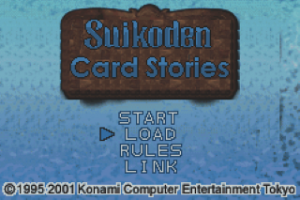 | |
| General | |
| Author | Pokeytax |
| Type | Translations |
| Version | 1.00 |
| License | Mixed |
| Last Updated | 2013/09/08 |
| Links | |
| Download | |
| Website | |
This is a fully playable translation patch for Suikoden Card Stories, the card-based spinoff of the Suikoden series for Game Boy Advance.
Aside from some animations in attract mode, all Japanese should be translated, all bugs should be fixed (although a few doubts remain) and some minor dummied content has even been restored.
This is now the most definitive retelling of Suikoden II’s storyline available, aside from Suikoden II itself, Suikoden I & II on PSP, the novelization, and probably the manga and radio drama.
Installation
| Game information | |
|---|---|
| Japanese title | 幻想水滸伝カードストーリーズ |
| Aliases | Genso Suikoden Card Stories |
| ROM information | |
| File | Gensou Suikoden Card Stories (J) |
| Length | 4194304 Bytes (32 Mbit) |
| CRC32 | 5E67AAB4 |
| MD5 | 0A3523DB 5FE9A032 9D766D9D 1FF5E654 |
| SHA1 | C01772CD 0416DDCA 38DCD1EF 63E53A4E BDA90BBC |
This patch is an .xdelta file, meant to be applied to a .gba version of the game.
Any of several patching utilities will work, such as xdelta UI (Win), Delta Patcher (Win/Linux) or MultiPatch (macOS).
You need to obtain a .gba file, the Japanese version of the game, yourself. Please consider supporting Konami for producing this game.
User guide
Translation notes
The translation isn't literal, but it shouldn't stray far from the original. The original, incorrect translations of names like the Zodiac Sword (Star Dragon Sword) and Mathers (Mazus) have been retained.
In addition, some cards are bugged in the game and do not function as their card text would suggest. (For example, the card South Window War should prevent all characters with the links H & I from being played, but this restriction only applies to the player, not to the AI.) These translations have been adjusted to match gameplay.
Hacking notes
Most of the game's text is Shift-JIS, except for two large banks of Huffman-compressed Shift-JIS. This patch uses a VWF 8x11 font based on the existing Roman font, stored internally as ASCII + 0x60. This allowed the use of twice as many letters in the same VRAM as the original 11x11 characters. The hack doesn't massively overhaul the routine to write the whole alphabet into VRAM, as the real bottleneck is the number of objects in OAM.
For this release, some limited sprite text welding has been implemented in order to better fit text and generally make stuff work right. It's still dotty in places because a lot of old wiring remained, but it's an improvement over the last release.
You may encounter occasional sprite glitches, but they should go away when you back out of the screen and return.
FAQ
Q. How to get the Best Ending?
There are three endings to the game. The more Ending Points you have, the more you gain access to. You gain and lose Ending Points based on the responses you choose.
The "correct" choices are at the end of this faq. They're very generic and will not spoil you, so feel free to refer to them. If you are following along and find you've missed one, don't worry, you can afford to skip a few - but be warned, it's difficult to get the best ending simply by trusting your instincts. There's always New Game +, though.
Q. Is Link Mode supported?
Link Mode is "weakly supported" (i.e. the text is translated, and it could theoretically work, but setting it up is a hassle and it was not tested).
Q. Is there a Secret Character?
In the original Japanese release, it was impossible to fully complete the game, due to one missing card.
That character was apparently intended to be distributed through special events and promotions, like Mew for the original Pokemon. But, the abysmal sales of Card Stories in Japan meant nothing ever materialized.
However, this card is fully functional, there are hints about this character in the original release, and there was even a complete cutscene dummied out. This character is now enabled, and it should be possible to get a 100% card file.
| Critical Choices |
|---|
| These are the "correct" choices, in order. You need to get maybe 80% right in order to access all endings.
|
Basic Tips
Mission and Facility cards let you determine the rules for a fight, but they won't help you win. Reducing the number of these in your deck will let you draw more characters. Later on in the game, using high VP missions helps you further cut back on Mission cards.
When you play a mission, or when your opponent plays one, you want a hand full of characters. So if you've drawn extra facilities or missions, or even lousy characters, consider discarding them until you have your best squad.
When you clear a mission, the character you station very rarely returns to combat. There's no mechanic where they have to defend the mission. However, that character cannot be played for the rest of the game, because they're still considered in play.
For that reason, it is critical that you station cards you won't need later. Ideally, station cards you only have one of in your deck; then, station cards that are weak, or cards you only have two or three of.
To use a Unite, play the character without the UNITE text on their card first. You then get a free play of the character WITH the UNITE text.
Cards that discard characters from play, especially characters of your choice, are generally very effective. Cards that return cards to your deck generally aren't.
At the very beginning, you will be short on leaders. You may want to swap out some weak followers and facilities or missions for any leaders you can find.
Fleeing a random battle in a dungeon before it starts only costs a little potch. But once it starts, even though you get unlimited continues, there's no way to escape except winning. So either save states frequently or be careful about picking fights.
If you can manage to trade five cards in at the Training center, you'll get a bonus card as a reward. However, be careful about trading your strongest cards along the way!
Advanced Tips
Occasionally, having an appropriate card in your deck will trigger an event and affect how many VP you need to win. For example, Sierra and the Star Dragon Sword are good to bring along against Neclord.
In dire situations, consider forgoing missions and facilities altogether and trying to piggyback on your opponent's mission cards instead. If you have failed the fight already and know what missions your opponent will be playing, sometimes it's easier to try and beat them at their own game.
The exception to stationing only weak cards is stationing cards that provide bonuses to other cards. Riou is a great card for you early on, but if you clear a mission and station him, all Alliance characters get +1 ATT for the rest of the game. If you station Jeane, your characters with Runes get +1 ATT (and if you put her on the Rune Shop, they get another +1 ATT!).
You can also try to station cards that are giving you fits, if you have your own copy. If you get your Seed stationed on a cleared mission, you don't have to deal with him for the rest of the game.
In general, despite attempts by the designers to make all the cards interesting, the game strongly favors cards with high base stats. Unless they directly remove your opponent's characters, cards with low ATT/MIL/BLD become increasingly outclassed as the game progresses.
It becomes difficult to build facilities later on, because usually they take two or three turns to build, two turns to destroy, and your opponent moves first. In later expansions, they fixed this by making Facilities much harder to scrap, but you're stuck with the game the way it is.
1 VP ATT missions suffer in a similar way; the head start your opponent gets matters a lot thanks to the low clear condition. Additionally, once you begin needing 4-5 VP, stationing characters can be a severe disadvantage. Someone with 2 1 VP missions and 2 Facilities cleared has four characters tied up for 3 VP. Playing and winning Take L'Renouille gets you 3 VP for only one character.
In the main story, you're going to be seeing a lot of MIL missions. So even if you're playing an ATT or facility focused deck, you need a reliable way of dealing with these, because...
Unfortunately, Highland cards are some of the best in the game, and you spend most of the storyline fighting the Highland Army. Solon Ghee, Han, Culgan, Seed, and Luca are all extremely difficult to deal with. Even though Rina offers 0 MIL in a military mission, getting rid of one of those five is still usually a good play. Shu's healthy MIL and ability to return a card to hand are extremely powerful.
Matches where you have to earn an overwhelming number of VP (more than 5) can be very difficult to win without running out of cards. Instead of trying to earn VP, you may want to add a few cards like Barbara or Warehouse to your deck and play a careful defense, trying to run your opponent's deck down first so they lose. Playing decoy Facilities that take your opponent two or three cards to destroy can help, since they don't grant any VP.
Screenshots
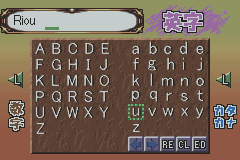
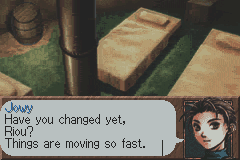
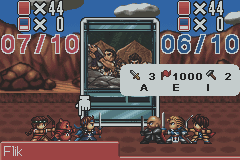
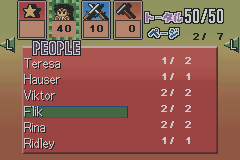
Changelog
1.00 Patch Complete
- Except for the attract mode animation, all Japanese text has been translated and all game features enabled. Dummied content was restored, allowing 100% completion.
0.81 Time to Relax
- Some minor upgrades; game is now completely playable. Forward progress on the patch is suspended, although I'll still take major bug reports.
0.80 Two Steps Forward, One Step Back
- Enough improvements to release a new version. Battle text tweaked and the second & third tutorials repaired. The Cafeteria and Recipes in general remain a disaster area and are best avoided.
0.751 One Step Forward, Two Steps Back
- Reverted to 0.70 to get around a stupid crash that should have been fixed. Rebuilding back to 0.75.
0.75 Crash Fixes
- Several more memory allocation bugs fixed. Slowly getting the shops displaying prices better.
- All enemy names and recipe names translated. This should significantly reduce or eliminate the crashing in dungeons.
0.70 Corruption Fixes
- Horrible memory allocation bugs causing corrupted savestates and inability to edit the deck fixed. Also a few minor bugs.
0.41 April Fool's
- Initial release 4/1/2012. Playable to the end with a lot of savestating, but many bugs/crashes/mistranslations.
Credits
Thanks to the hardworking team at the Suikogaiden Translation Project, led by Rin-Uzuki and later Raww Le Klueze, which inspired me to pick this up. Don't forget to check out Suikogaiden Vol. 1 & Vol. 2.
This translation heavily referenced Zaltabor's translations of cards for the initial pass-through - it sped things up considerably.
ARMIPS and No$gba were very useful tools for this project; thanks to Kingcom and Martin Korth, respectively.
External links
- Romhacking.net - https://www.romhacking.net/translations/1720/